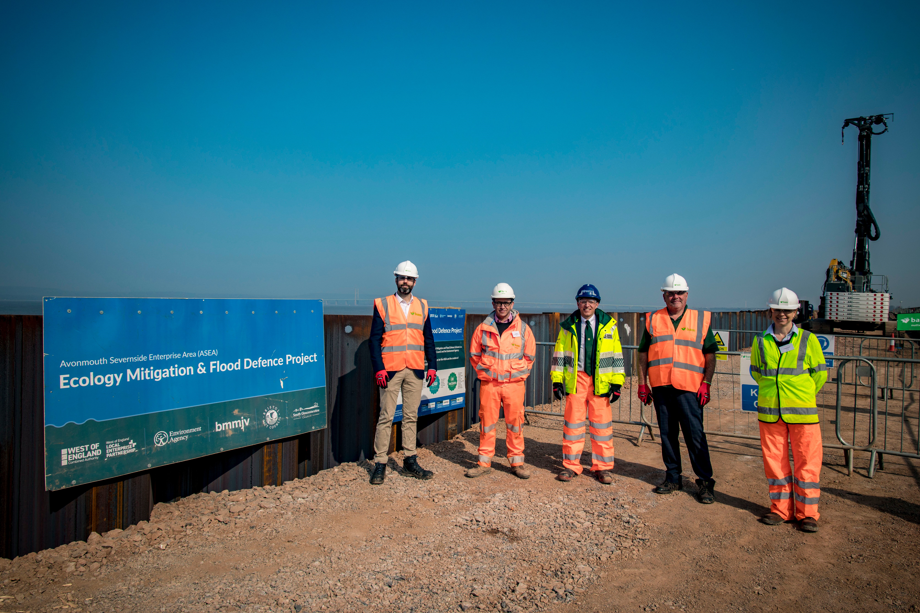West of England leaders visit Bristol Port as vital flood defences take shape

25 March 2022. In March we marked another milestone, with work having started in earnest at the Bristol Port. Following extensive survey works carried out last year, leaders from around the West of England gathered to see for themselves the installation of new sheet piled flood defence walls that will help protect homes and businesses from flooding and unlock new jobs, delivering a significant boost to the local and regional economy.
The sheet pile walls are one of several forms of flood defence used throughout the 17km project area. These are steel sheets that are driven deep into the ground and are well-suited to the area around the port as they take up only limited space in the industrial area, with installation causing little disruption to the operations of the port. The sheet piles, delivered directly to the port via boat, have the additional benefit of a reduced carbon footprint compared to a reinforced concrete wall.
The ASEA project is a partnership between Bristol City Council, South Gloucestershire Council and the Environment Agency.
Cllr Don Alexander, Cabinet Member for Transport at Bristol City Council and Avonmouth and Lawrence Weston ward member, said: “The start of flood defence work at the port is a major milestone for the project, which continues to progress on schedule. Around 2,500 homes and businesses will be better protected as part of the scheme, a significant number of which are in Avonmouth and Lawrence Weston ward. I’m delighted to see the progress of work taking place here that will help protect against the increasing challenges of climate change for decades to come.”
Cllr Toby Savage, Leader of South Gloucestershire Council and Cabinet Member with responsibility for Climate Change, said: “This work taking place at Bristol Port will deliver significant benefits for the whole of the Avonmouth and Severnside area and beyond, and is critical for the future economic prosperity of the wider West of England region. The new and improved flood defences here will help give businesses the confidence they need to further invest and deliver 12,000 new jobs by 2026/27 when the overall project is scheduled to be completed.”
John Chaplin, The Director of External Affairs & Special Projects at Bristol Port Company, said: “The new flood defences are of the utmost importance to Bristol Port, which is a major economic driver for the South West and supports over 10,000 jobs through port-based businesses.”
Colin Taylor, Senior Flood & Coastal Risk Management Advisor at the Environment Agency said: “The stretch of coastline through Bristol Port and Lamplighter’s Marsh is the longest continuous area of flood defence for the entire project. We have been hard at work throughout the area, not only at the port but also at Lamplighter’s Marsh where we have been clearing vegetation in preparation for the building of new flood defences.”
The largest of its kind in the region, the £80m project will provide 17km of new and improved flood defences, from Lamplighter’s Marsh in the south to Aust in the north, once complete in 2026/27. The defences will help reduce flood risk to around 2,500 homes and businesses over the scheme’s lifetime. It will also create a minimum of 80 hectares (the equivalent of around 112 football pitches) of new wetland habitats for the internationally important Severn Estuary’s bird species.
Funding for the project has come from the West of England Local Enterprise Partnership, administered by the West of England Combined Authority. Other funding sources are the Government’s Flood Defence Grant in Aid, and Local Levy raised by the Wessex Regional Flood and Coastal Committee. The contractor is BMMjv (https://asea-flood-ecology.co.uk/bmmjv-explained/).
Watch our video below to see the defences being installed.
